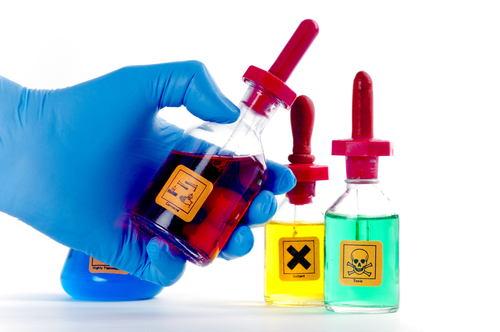Are chemical-resistant gloves required in your workplace? How do you select the right ones?

When it comes to chemical-resistant gloves, several choices exist, and there are a number of issues to consider when selecting the right glove:
- Consider the type of chemical. Acids, caustics, solvents, and oils have different requirements for gloves.
- Chemical contact considerations include the frequency and duration of contact, whether the glove is immersed in the chemical, and the chemical concentration. Usually, thicker glove materials will protect better against higher frequency and duration of use and against higher chemical concentrations.
- Abrasion and cut resistance must be considered if there is potential for a puncture, cut, snag, or tear.
- The length and cuff type (knit, wrist, gauntlet) are important depending on whether you will immerse your hands only, your entire arms, or only use the material with a rag to wipe parts.
- Dexterity and grip must also be considered. If you are working with small intricate parts and chemicals, the glove will have to be thin to provide better dexterity. If the chemical is oily, soapy, or otherwise slippery, the gloves may require extra grip.
- Thermal protection may be required if you are dipping your hands into heated chemicals.
Your hands are your most valuable resource. Because they are crucial for our lives and work, we must protect them. Get the vital safety information you need in a Free Best Practices Report. Find out how to get your copy. Click here
Options
Chemical-resistant gloves are made from many different materials, because a single glove to protect against every type of chemical has not been invented. It is very important that you use the right glove material to protect against the chemical you are using. Here are some options:
- Butyl, a synthetic rubber, works well for a variety of chemicals such as ketones, esters, alcohols, most inorganic acids, and caustics.
- Latex, or natural rubber, has good protective qualities against a variety of chemicals including most acids and caustics, salts, detergents, and alcohols. However, many solvents will break latex down.
- Neoprene, a synthetic rubber with better properties than natural rubber, has good protective qualities against a variety of chemicals such as oils, acids, caustics, and some solvents.
- Nitrile protects against a number of acids and caustics as well as some solvents and fuels.
- Polyvinyl chloride (PVC)-coated gloves have good protection against some solvents, oil, and grease, as well as acids and caustics.
- Polyvinyl alcohol (PVA) gloves protect against aromatics, ketones, and chlorinated solvents.
- Viton works well against aromatics, hydrocarbons, chlorinated solvents, ketones, acids, and amines.
- Silver shield gloves resist permeation and breakthrough by more chemicals than any other material.
According to the Bureau of Labor Statistics (BLS), hand and finger injuries are second only to back strains and sprains in lost workdays. Make sure your workplace is safe. A free Best Practices Report can tell you what you need to do. Find out more.
Select the Right Gloves to Prevent Employee Hand Injuries
Your hands are your most valuable resource. Because they are crucial for our lives and work, we must protect them. Protecting hands from injuries is a fundamental part of most workplace safety programs and glove wearing is one of the most effective industrial injury prevention programs.
Hand protection is so important that it is required by the Occupational Safety and Health Administration (OSHA). The Agency has mandated that employers provide, at no cost to employees, almost all personal protective equipment (PPE)—this includes cut-resistant gloves.
Gloves are valuable protective devices but do not give absolute protection. Their effectiveness depends on how the PPE is chosen, used, and stored. Selecting the best glove to protect your employees’ hands can actually be a complex task. Many types of gloves are available and each has different uses. But the right cut-resistant hand protection does make a difference.
Learn more about how to protect your employees with the help of a FREE special report, Cut-Resistant Hand Protection, brought to you by BLR and Worldwide Protective Products, a leading manufacturer of high performance hand and arm protection. To access the report, click here.
